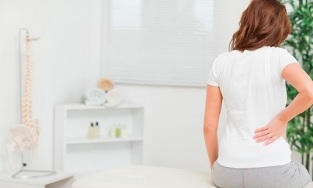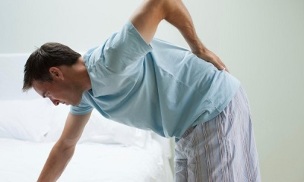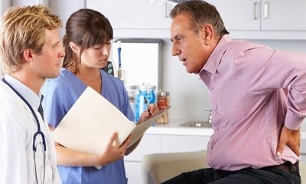
Low back pain is a symptom that can be associated with various diseases. They can be permanent or intermittent, local or generalized.
If a person has pain in the lumbar spine, a comprehensive examination is prescribed to identify its cause.
Possible causes and characteristics of low back pain
Low back pain can be caused by a variety of causes, depending on the extent to which the severity of the discomfort varies. Pain syndrome reduces a person’s quality of life, limits mobility, and makes it impossible to perform everyday tasks.
There are many causes of back pain in the lumbar region. Some of them require quite serious and immediate professional intervention.
Lumbar sciatica
Lumbar sciatica is a musculoskeletal disease in which the roots of the spine are compressed and inflamed. This pathology is secondary in nature as it develops in the background of degenerative processes in the musculoskeletal system.
Common symptoms in this case are:
- Pain syndrome aggravated by sudden movements and weight lifting. The localization of pain depends on the degree of damage. The syndrome can affect the lumbar and pharyngeal regions, the back or front of the thigh. If the nerve endings located under the first and second lumbar discs are damaged, there is lumbago in the lumbar region and buttocks of the patient.
- Increased pain severity in case of cough, sneezing.
- Inability to stay in one position for a long time.
- Mobility disorders: inability to tilt the boot freely forward, backward or sideways, inability to bend the fingers of the lower limbs.
With lumbar spine radiculitis, the pain usually occurs suddenly and resolves spontaneously. The next time the pain becomes more intense, it becomes more pronounced.
Osteoporosis
Spinal osteoporosis is a phenomenon in which the process of calcium leaving the bones takes place and the activity of the cells responsible for bone growth is interrupted. Under these conditions, the bones die quickly and their density is constantly decreasing. Osteoporosis is difficult to suspect in the early stages of development.
Most often, the patient feels sharp pain in the lumbar spine during periods of intense tension - with a sharp twist, fall, or weight gain.
In addition to severe low back pain, osteoporosis has manifestations such as:
- chronic fatigue;
- abdominal bulge;
- Spinal immobility.
Compression fractures caused by osteoporosis of the lumbar spine result in acute pain that is exacerbated by palpation of the affected area as well as muscle cramps.
Scoliosis

With the lumbar spine, its structures deviate to the right or left. These changes are reflected in the state of the surrounding tissues: they become irritated, inflammatory foci appear in the muscle-lobe structures.
Left-sided scoliosis is most often diagnosed. In left-handed people, scoliosis develops on the right side.
In the initial stage, lumbar spine scoliosis may not appear in any way. Negative changes can only be tracked by X-ray results.
In this case, the typical symptoms in addition to severe lumbar spine pain are:
- slouch;
- swelling in the lumbar region;
- chest pain;
- displacement of the pelvic girdle, resulting in one lower limb becoming shorter than the other;
- blade divergence.
Characteristic features of pain in lumbar spinal scoliosis: appearance at the beginning of physical activity, decrease in the intensity of discomfort while walking. The pain usually lasts for a short time.
Injury
Lumbar contusions occur during falls and blows. The lumbar region is most susceptible to trauma.
Lumbar spine bruises are closed damage to tissues and a portion of the spine that does not cause anatomical abnormalities. This type of injury is common in athletes as well as people working in the workplace.
In case of bruising, the following additional symptoms may occur:
- hematoma formation;
- redness;
- increased pain when you press the site of injury.
If the bruise is severe, the conduction of nerve impulses in some zones of the lumbar spine may be impaired, in some cases a complete loss of sensitivity.
Symptoms are more pronounced than lumbar injury and include:
- pain when touching the affected area;
- growing hematoma;
- pain when turning the body, inability to bend;
- swelling in the ankle area, indicating poor circulation;
- paralysis and paresis of the lower extremities.
Rheumatoid Arthritis
Rheumatoid arthritis of the spine is another likely cause of lumbar pain. In this case, the joints in this area are affected.
Rheumatoid arthritis pain most often occurs at night, usually in the morning. In the initial stage, the syndrome can be suppressed with the help of special exercises, but at night the pain reappears.
Other symptoms: increased local temperature in the affected area, accumulation of fluid in the cavity of the affected joint.
Osteochondrosis
Osteochondrosis is a pathological process in which intervertebral discs lose their elasticity. As the disease progresses, cracks appear in them and hernias form.
In the early stages of osteochondrosis, lower back pain is rare and does not vary in intensity. They will be given a pronounced chronic character in the future. The patient feels stiffness in movement, constant fatigue. There are difficulties in bending and lengthening the back.
Pain often radiates to the lower extremities. At the same time, tingling and numbness occur.
The intensity of discomfort increases with increasing physical exertion, sudden movements and weight lifting.
Malignant tumors
If the back hurts in the lumbar region, it can be as dangerous a pathology as cancer. In this case, a malignancy does not necessarily affect the bone structure of the spine. In this case, the pancreas, which is located behind the stomach, may be affected, so the pain can be given to the lower back. Severe pain indicates an advanced stage of cancer.
Pain in the lumbar region may also be associated with the fact that tumors of other organs have metastasized to the indicated area.
In women, cramping low back pain can be a sign of developing ovarian cancer. In men, sharp and prolonged seizures indicate prostate cancer.
Gynecological Diseases

Women are often worried about lower back pain. Similar symptoms may occur with pathologies such as:
- ovarian tissue rupture;
- pathological processes of the uterus;
- cysts in the ovaries;
- cervical cancer;
- inflammatory processes in the fallopian tubes;
- benign formations on the inner wall of the uterus.
Low back pain often occurs in women who have had an abortion. Unpleasant sensations are caused by mechanical damage to the tissues of the uterus and a prolonged process of wound tightening.
In women with gynecological disease, low back pain, pulling, pain. In addition, violation of the menstrual cycle, loss of strength, irritability, increased body temperature. Often, pain syndrome is complemented by vaginal secretions of different consistency and color.
Pain syndrome in this case is caused by hormonal imbalances and inflammatory processes that spread to the tissues of the lumbar region.
Kidney disease
Lower back pain is a sure sign of kidney disease.
A similar symptom is associated with pathologies such as:
- urolithiasis;
- pyelonephritis;
- glomerulonephritis;
- nephroptosis (kidney prolapse).
In the presence of urethra in the urinary tract, the pain in the lumbar region is not very pronounced, dull in nature. With inflammatory processes affecting the kidneys, the pain is painful and constant. The location of the localization in this case is on the left and right sides of the spine.
Acute pain refers to renal colic. The pain radiates to the lumbar area, the inner thigh, the anterior abdominal wall.
Other manifestations that may indicate kidney disease include:
- increased blood pressure;
- swelling of the arms, legs and face after waking up and disappearing during the day;
- change in urination: the process can be quick and painful or, conversely, rare, until complete cessation;
- lethargy;
- increased sweating;
- decreased appetite.
Discomfort and low back pain are often associated with the fact that the fetus presses on the kidneys in pregnant women. In this case, the pain syndrome is not associated with any pathology, it is a completely natural phenomenon.
Diseases of the genitourinary system in men
In the stronger sex, lower back pain often occurs in diseases of the urogenital system. Most often, the discomfort is caused by inflammation of the prostate, an inflammatory process in the prostate gland. With this disease, the urination process and sexual function are interrupted. In addition to lower back pain, there are pulling pains in the lower abdomen.
Another male disease that contributes to the appearance of pain in the lumbar region is epididymitis, an inflammation of the epididymis.
Lumbar myositis
Lumbar myositis is an inflammatory process of muscle tissue that manifests itself in muscle pain and weakness, sometimes in atrophy. The disease can be caused by infectious processes, traumas, hypothermia, metabolic disorders of the body.
This pathology is characterized by the following:
- painful pain in the lower back that gets worse with movement;
- feeling of dull weakness in the muscles;
- Swelling, redness.
Bone tuberculosis

With tuberculosis of the spine, the lower back often hurts. The nature of the pain syndrome in this case depends on how many vertebrae are involved in the pathological process and the degree of deformation of the structures.
The main signs of spinal tuberculosis are:
- Severe pain in the lumbar region. This localization is due to the fact that the lumbar region is the largest part of the spine that receives the maximum load.
- Increased sweating at night.
- Increase in the size of the lymph nodes.
- The temperature rise is within 37, 1-37, 3 degrees.
- Constant fatigue.
As tuberculosis of the spine progresses, this structure has an angular curvature, the formation of abscesses in the lumbar and thoracic region.
Culmination
Fading of sexual function is often associated with low back pain in women. A similar phenomenon is associated with a decrease in ovarian activity, which is reflected in estrogen hormone levels. In its absence, bone tissue becomes more fragile and prone to damage.
Against the background of hormonal changes, the musculoskeletal system as a whole becomes vulnerable: the intervertebral cartilage and discs weaken, and the muscles and ligaments lose their elasticity. As a result, the lumbar region, which is always under the greatest stress, is particularly vulnerable.
In addition to lower back pain, postmenopausal women suffer from headaches, excessive sweating, and hot flashes.
Vascular pathology
Violation of blood circulation caused by abnormal vascular processes can also cause pain in the lumbar region. Thrombophlebitis, atherosclerosis, phlebotrombosis contribute to the development of pain syndrome.
The occurrence of blood clots in the veins, inflammation of the blood vessel wall, narrowing of the lumen of the blood vessel - all of which impede the full flow of blood and thus limit the supply of oxygen to the tissues and structures of the body, which negatively affects their condition.
Other symptoms associated with vascular disease include swelling of the veins, heaviness in the limbs, and bluish skin.
Intestinal Diseases
In bowel disease, pain can radiate to the lower back. This is due to the fact that the intestinal system occupies a significant place in the abdominal cavity. If any part of it goes through pathological changes, it grows and puts pressure on other organs. The spine is also in danger.
Pain extends to the lumbar zone in ulcerative colitis, exacerbation of appendicitis, intestinal obstruction, irritable bowel syndrome.
In the case of pathological processes that spread to the stomach, the pain is localized in the upper part of the lower back. They appear after a meal, with a feeling of hunger, in case of abuse of harmful products.
The following symptoms may occur in parallel:
- bloating;
- stool disorders;
- abdominal pain.
Obesity
Being overweight puts additional stress on the spine, especially the lumbar spine. Constant pressure creates the risk of musculoskeletal pathologies, causes damage to the intervertebral discs, curvature of the spine, and the development of osteochondrosis.
In addition to the above pathological causes, pain may occur in the lumbar zone due to prolonged driving or the computer, excessive strain in the gym, summer home hobbies, and a sedentary lifestyle.
Which doctor should I go to?
Back pain is often caused by severe disorders of the body, so it is important to see a doctor in good time to diagnose and treat the real cause.

You need to see a specialist if your patient has pain in the lumbar region:
- regular;
- appears constantly after physical exertion;
- does not disappear when lying down;
- is associated with numbness of the limbs and an increase in body temperature.
The main professionals you should contact if your back hurts in the lumbar region are:
- vertebrologist (treats osteochondrosis and other neurological diseases);
- neurologist;
- Nephrologist (Urologist): This specialist diagnoses and treats when lower back pain is associated with abnormal processes in the urogenital system.
If necessary, other professionals are involved in the diagnosis and treatment process: orthopedist, surgeon, gynecologist, oncologist, gastroenterologist.
Diagnostics
In case of lumbar region pain, the following diagnostic measures are prescribed:
- general examination, identification of anamnesis;
- test to determine restrained nerve endings;
- blood test to measure hemoglobin levels;
- myelography;
- X-ray examination of the spine;
- MRI;
- CT;
- ultrasound of the abdominal organs;
- endoscopy of uterus, stomach, intestines;
- bone scintigraphy.
The activities listed allow the patient to be prepared for a complete condition, to identify the disease causing pain in the lumbar spine, and to determine the appropriate treatment process.
Approaches to treating low back pain
The main process of treating low back pain depends on what caused the symptom. Therapy is aimed at eliminating an existing disease.
General Principles
Treatment is based on
- use of drugs to suppress inflammatory processes;
- implementation of physiotherapy procedures aimed at accelerating the recovery of affected structures;
- physiotherapy exercises.
During treatment, the patient should avoid active sports activities as well as any physical activities in order not to aggravate the course of the pathological process. During the rehabilitation period, the patient is advised to practice yoga, swimming and hiking in the fresh air.
Therapy includes diet modification. The patient should reject heavy foods, all fatty and fried. It is important to give up bad habits - this will significantly speed up the healing process.
Medications

For pain in the lumbar region, medications are usually prescribed in the form of injections that contain vitamin B. The functions of such drugs are:
- acceleration of damaged nerve fiber recovery;
- increase in functional activity of the central and peripheral nervous system; Acceleration of metabolic processes.
In case of severe, intense low back pain, strong painkillers are prescribed.
Non-steroidal anti-inflammatory drugs that control inflammation are also given by injection.
Following the injection of non-steroidal anti-inflammatory drugs, drugs in this group are prescribed in the form of tablets for oral administration.
Medications such as muscle relaxants are prescribed for muscle cramps that cause low back pain.
Patients are also prescribed external medications. They usually have a warming effect and help suppress pain. They are only prescribed as part of a comprehensive treatment.
Special ointments are recommended for pain in the lumbar region.
Physiotherapy
A series of therapeutic exercises is prescribed only after the pain syndrome has been reduced. During exacerbation, therapeutic practices are contraindicated.
The following exercises are recommended for lumbar region pain:
- Raises the pool region.You need to lie on your back and bend your legs at right angles. The pool should be carefully lifted and returned to its original position. Repeat 10-15 times.
- Maintain balance.The exercise is performed in a standing position. You should stand on your toes and try to maintain balance in this position for about 10-15 seconds. Repeat 3-5 times.
- Lift your legs out of position.Lie on your back, alternately raising your straightened lower limbs as high as possible. Make 5-10 raises on each leg.
- Movement on the bottom.You have to sit down on the floor, adjust your back. Use the pool and bottom to move forward and then backward. In this way you have to walk about 2 m forward and back as much. The number of approaches is 2-3.
Gymnastics is prohibited in spinal cord injuries, tumors and hernias, as well as in acute diseases.
Physiotherapy
Physiotherapy procedures are performed provided that the lower back pain is not caused by an acute inflammatory process. Acute pain syndrome is initially alleviated by conservative methods and only then is physiotherapy prescribed.
The following procedures are prescribed for lumbar region pain:
- Magnetotherapy.This method improves blood circulation in the affected area.
- Electrophoresis.This method is needed if you want to speed up the delivery of drugs to your injury (painkillers, non-steroidal anti-inflammatory drugs, chondroprotectors).
- Laser therapy.The technique allows the normalization of metabolism and the improvement of blood circulation in the affected areas.
Nutrition
To strengthen the bone elements, the diet should include cottage cheese, dairy products and, in fact, whole milk, fatty seafood, brown bread.
If the patient is overweight, which puts extra strain on the spine, flour, sweets and sugary carbonated drinks should be excluded from the diet.
Folk remedies
Traditional treatment methods should by no means become the cornerstones of low back pain therapy. It is used as an adjuvant only and is only used with the approval of your doctor.
For low back pain, you can use the following traditional medicine recipes:
- Honey-based ointment.To prepare the medicine, take 3 tablespoons of natural bee honey and melt it in a water bath. Cool the composition. Add 2 tablespoons of pharmacy alcohol to the honey, add 100 g of Vaseline and rub into areas where the pain is localized. You can apply compression with this ointment for greater effectiveness. In this case, they are not rubbed into the skin, but are distributed in a thin layer on it and foil is applied to it and wrapped in a warm scarf on top. Leave the compaction for 3-4 hours and then wash the preparation with warm water.
- Salt compaction.Dissolve the table salt in hot water (ratios - 1: 10), stir. In the finished solution, moisten a gauze fabric folded in several layers, cover the lower back with a compress, wrap it with a towel, and warm with a scarf. Leave overnight to remove any remaining compress.
- Garlic compression.3 heads of garlic should be taken, peeled, chopped. Pour the resulting mass with warm water (2 glasses), leave for 3 hours. Moisten a cotton cloth with the infusion and sprinkle with freshly squeezed lemon juice all over the surface. Apply a cold compress. Leave a damp towel for 20 minutes to reach body temperature. Then repeat the procedure for applying compression. This can be repeated until the patient feels relief.
- Compress with body.Bodyagi powder should be mixed with olive oil in a ratio of 1: 30. Lubricate the sore lower back with the resulting composition and leave the product on the skin for 40 minutes. After the specified time, the product must be washed with warm water.
- Compression of dried burdock leaves.Moisten the raw material in boiling water, fix it on the back, cover with a warm scarf on top. Leave the compression for at least an hour.
- Baths with additives.Bathing can reduce the severity of pain. 200 g of mustard powder and 600 ml of broth on mint leaves can be used as an additive. Bathe within 20 minutes. The water must be warm.

All of these treatments are intended to relieve back pain, i. e. symptomatic.
Treatment of a specific diagnosed disease should be performed according to a separate schedule.
Prevention
To reduce the risk of low back pain, do the following:
- monitor your posture;
- stand and walk only with your back straight;
- perform special exercises to strengthen the spine and back muscles;
- do not expose your spine to excessive strain, do moderate exercises that use your back muscles;
- avoid hypothermia;
- If possible, do sports that do not adversely affect your spine: swimming, yoga, walking are especially helpful;
- Do not make sudden movements when lifting loads;
- sleep on a medium-hard mattress, which is best - orthopedic, the pillow should be orthopedic and medium-sized;
- track your weight if necessary, follow a diet and engage in special exercises to overcome excess pounds;
- takes vitamin and mineral complexes, especially during periods of hormonal changes in the body.
Back pain can be associated not only with diseases of the spine but also with disorders of the internal organs. The person skilled in the art can determine the true cause of the pain syndrome during diagnostic procedures. The symptom itself and its cause must also be treated.

























